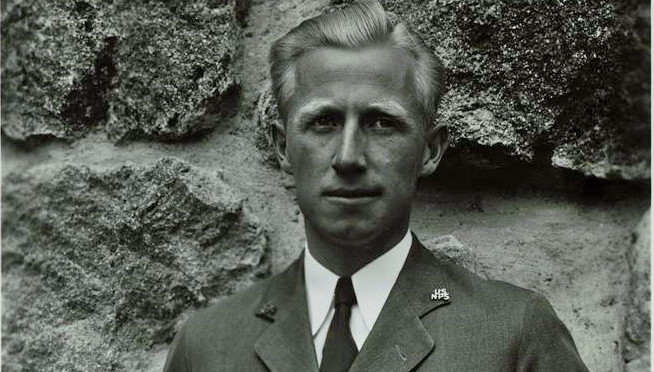About six or seven offices in there now. But there’s that visitor reception area and the auditorium.
That building was never planned to be an office building. So, when they had to have an office space—and the only building they had they had a little frame structure [the old administration building] was terrible so when the ranger’s dorm was done they decided to, use a lobby of that building as office space. And that’s why you see that door. That door coming in there to the left would normally have taken you into kind of a big lobby, and then you’d walk straight ahead as you come in and you go up the steps to go up the stairs. Now, that was all based on a dormitory, but when they came along they had to have office space so they used the lounge area as an office space until the new administration building was built. So they used that about two summers. But rangers still come in and slept upstairs. They’d bunk upstairs in the big room. And, I was on one end, Sager and I had one room on the far end. Jean Steel was down on the first floor. Then they had a couple guest rooms for when Washington “big shots” would came, they had a room for them. But when the administration building was finished in ’35, then they all went over to the building there, see.
Styles of lettering, I just designed my own. I didn’t copy anybody’s design, just worked it out. I mean, I realized when you lettered you would make letters heavy and bold so they stand out. I never copied anything out of a book. My drafting experience (or other people’s drafting experience) we use what we think is appropriate lettering. And what you see, the lettering we did, represents what I thought when I started these signs. Or maybe I got the ideas from somebody else, I don’t know what. But I don’t say, “I was adhering to a design.” I just designed a type of lettering that I thought looked nice. There’s a lot of designs of lettering that you can go to. You can go into designs of letters straight, horizontal, vertical. There’s a lot of little niceties you can add to it. Like a cheap watch or a finely designed watch, there’s a lot of things you can elaborate on. But, it was a matter of personal selection and observation. I don’t think it was copied from any book of lettering. You could buy books on lettering, and you could find 50 or 75 types of lettering. Classical, ancient type lettering, you can see all that, you can get that in the library. But we just took a good conventional, practical lettering, that’s all what you see. This is good to the eye, that’s all we looked for. So, we didn’t …I didn’t copy anybody’s letters, to hell with them. It wasn’t that complicated of a problem. I think I worked this summer…. I’m trying to think when I first worked on the master plan, I think Sager had me work on some planning down at Sequoia ’29 or ’30, I forget, really I do. When I really got involved in the master plans of CRLA was about in 1933. What was a custom in those days. My job like many other jobs, park landscape in many other parks, I was called a resident landscape architect working under the supervision of the San Francisco office. And I was assigned, as resident landscape architect, to CRLA and Lassen Park. Therefore, it became my responsibility every fall, when I came in from CRLA, around October to revise master plans for those two parks and other National Monuments I had to work on and have them ready by the following spring. Which were approved and distributed to the various parks and other NPS officials concerned.


